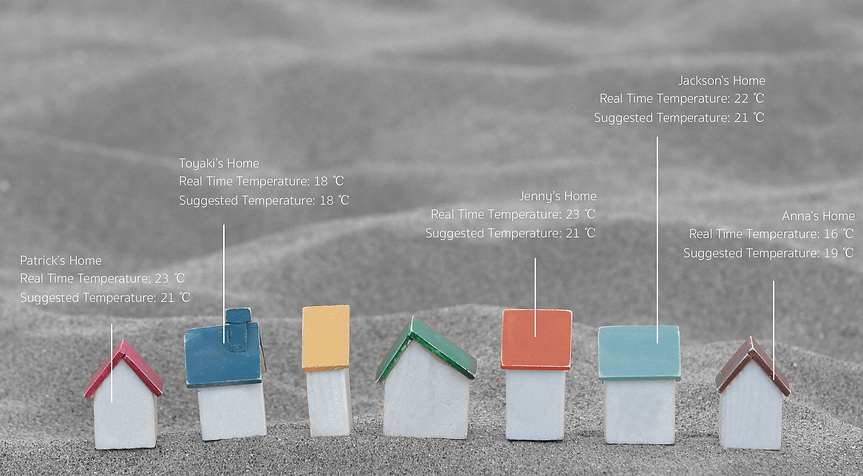CommunityWarm
FEB 2015 - NOW / Semester 2, MA: Design Informatics - personal project
Master Research Topic -Empathy and Design,Series 2
1. THEORY
Project CommunityWarm is based on two topics, one is "Heat and City (the theme that works with Edinburgh City Council)", and another is personal previous research topic "Empathy".
I'm thinking of a way that can help people to make wise use of thermal energy in a small community, to help people have a better understanding of the situation of others in one community and then guild people to change their energy using behaviour.
Is there an invisible algorithm that can perceive and detect the things (e.g. locations) where there is an imbalance between cold and hot, and if so, is that possible to provide a possible solution to resolve this imbalance?
2. RESEARCH
2.1 Improper Using Behaviours of Heater
From a survey in Australia, 36 per cent of people keep the gas dial at 25C (77F) and one in 20 have it turned right up to 30C (86F).
From the statistic of UK Energy Saving Trust, turning the thermostat up when it’s cold outside (52 per cent of people do this,) This shouldn't be necessary, because the very purpose of the thermostat is to maintain the desired temperature, whatever the weather.
"Turn it down. Many of our rooms are overheated. If you can bear to turn the thermostat down by just one degree you could save £65 a year on heating costs."
--- Michelle Roberts, BBC News
2.2 Different Opinions of Comfort Indoor Temperature
Comfort cannot be defined absolutely, but the World Health Organization's standard for warmth says 18C (64F) is suitable for healthy people who are appropriately dressed.
According to the West Midlands Public Health Observatory (UK), 21 °C (70 °F) is the recommended living room temperature, and 18 °C (64.4 °F) is a good bedroom temperature.
HSE: The law does not state a minimum temperature, but the temperature in workrooms should normally be at least: 16°C, or 13°C if much of the work is physical.
The variation in temperature with time and between rooms differed greatly from one house to the next. The graph below shows temperature variation in three houses during the same week.
This study has shown that differences in the temperatures between rooms in UK homes varies from one home to the next due differing occupant behaviors relating to: usage of rooms, duration of heating period, personal temperature preferences and understanding of the heating system.
http://www.arcc-network.org.uk/wordpress/wp-content/pdfs/4M-poster8-Variations.pdf
2.3 Temperature Variations in UK Heated Homes

3. PROTOTYPE

CommunityWarm could be used in a small community. It can be used to display the real-time indoor temperature, and provide best suggestions of temperature adjustment in each house in the community.


Mode 1 : display real-time temperature
- Press button
- Mode 1 tube switch opens; mode 2 tube switch closes.
- Thermistor sense temperature, output temperature value
- Compare Temperature with last temperature
- If it changes, servo start to rotate; if it doesn’t, remain still.
Mode 2 : calculate the suggest room temperature (ideal mode)
Working Principle
- Press button again
- Mode 1 tube switch opens; mode 2 tube switch closes.
- Read the liquid level (transfer it to temperature value)
- Calculate the which syringes need to move
- Calculate moving method.
- Start to transfer liquid (from the lowest temperature syringe)

Calculate Example (4 Syringes)
If the indoor temperature is between 19-20 ℃ (perfect range), stay still;
18-21 ℃ is the safe range (make sure the temperature is in the safe range at first, then try to adjust it into perfect range.


